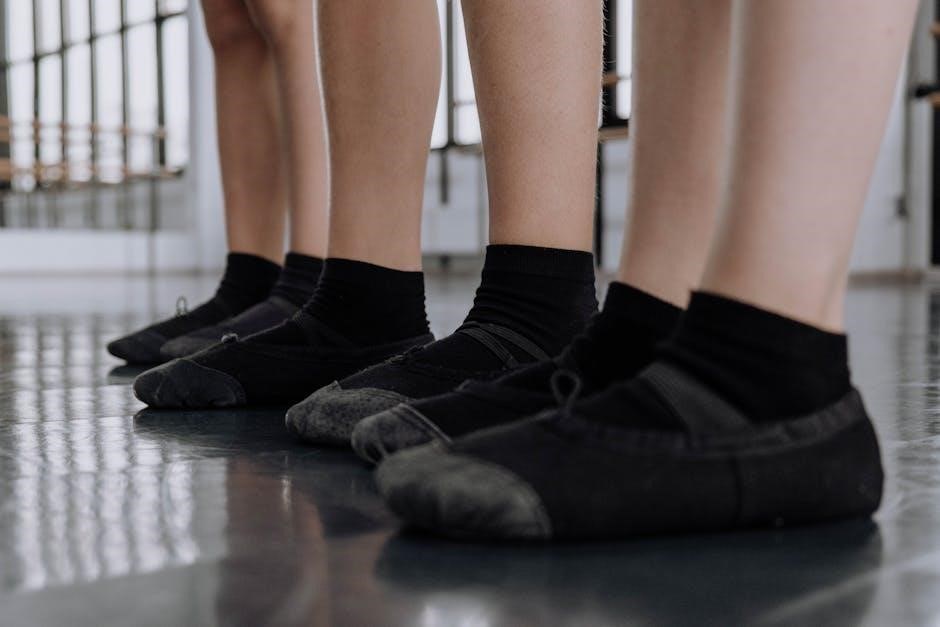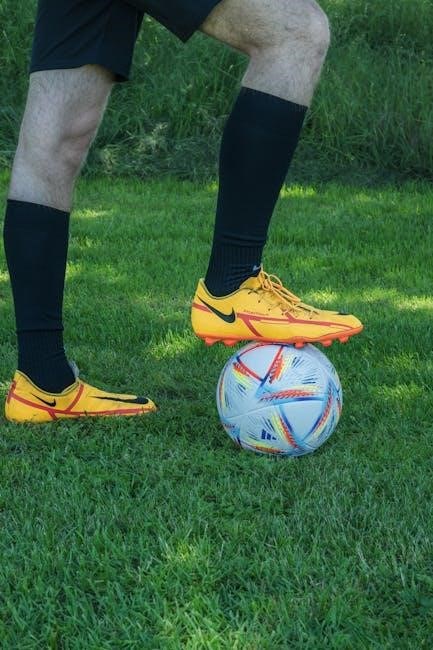
standing leg exercises pdf
Standing leg exercises are essential for building lower body strength and improving balance. They enhance muscle tone, stability, and flexibility, making them ideal for all fitness levels.
1.1 Importance of Standing Leg Exercises
Standing leg exercises are crucial for enhancing lower body strength, balance, and stability. They target key muscle groups like calves, quads, and hamstrings, improving overall leg function. Regular practice boosts mobility, reduces injury risk, and enhances athletic performance. These exercises are versatile, suitable for all fitness levels, and can be done anywhere. Consistency in performing standing leg exercises promotes long-term muscle development and supports daily activities requiring strength and coordination. They are a cornerstone of any effective leg workout routine.
1.2 Benefits of Standing Leg Exercises for Strength and Flexibility
Standing leg exercises significantly improve strength, flexibility, and overall lower body function. They enhance muscle endurance, balance, and coordination while targeting multiple muscle groups simultaneously. These exercises promote flexibility by allowing a full range of motion, reducing stiffness, and improving joint mobility. Regular practice strengthens the calves, quads, hamstrings, and glutes, contributing to better posture and reduced injury risk. Their accessibility makes them ideal for all fitness levels, fostering a well-rounded and functional lower body workout that supports daily activities and athletic performance.

Types of Standing Leg Exercises
Standing leg exercises include calf raises, leg extensions, side leg lifts, and hip abductions. They can be modified with weights or resistance bands for added intensity and focus on balance.
2.1 Standing Calf Raises

Standing calf raises target the calf muscles, improving strength and flexibility. Stand with feet shoulder-width apart, raise heels off the ground, and hold for 3 seconds before lowering slowly. This exercise enhances ankle stability and muscle endurance. For variations, weights or resistance bands can be added to increase intensity. Consistency in performing calf raises helps in developing strong, defined calves over time. Proper form ensures effectiveness and minimizes injury risk.
2.2 Standing Leg Extensions
Standing leg extensions focus on strengthening the quadriceps by lifting one leg while maintaining balance. Stand tall, hold onto a counter for support, and slowly lift one leg straight out in front or to the side. Hold for a few seconds before lowering. This exercise improves balance, flexibility, and overall leg strength. It’s ideal for beginners and can be modified by adding weights or resistance bands for advanced workouts. Regular practice enhances muscle endurance and stability.
2.3 Standing Side Leg Lifts
Standing side leg lifts target the hip abductors and outer thighs, enhancing balance and flexibility. Stand tall, hold a counter for support, and lift one leg straight out to the side. Hold for a few seconds, then lower slowly. This exercise strengthens the gluteus medius and minimus muscles, improving hip stability. Perform 10-15 repetitions on each leg, gradually increasing as strength improves. It’s an effective move for toning and balancing the lower body, especially when combined with other standing exercises.
2.4 Standing Hip Abductions
Standing hip abductions target the hip abductors, improving stability and balance. Stand with feet shoulder-width apart, hold a chair for support, and lift one leg outward, keeping it straight. Avoid swaying or using momentum. Hold for 2-3 seconds, then lower slowly. Perform 10-15 repetitions on each leg. This exercise strengthens the gluteus medius and minimus, enhancing hip mobility and overall lower body stability. It’s particularly beneficial for improving gait and reducing the risk of hip-related injuries when done consistently.
Muscle Groups Targeted by Standing Leg Exercises
Standing leg exercises target the quadriceps, hamstrings, calves, and glutes, enhancing overall lower body strength and functionality. They also engage hip abductors for improved stability and balance.
3.1 Quadriceps
The quadriceps, a group of four muscles on the front of the thigh, are heavily engaged in standing leg exercises like leg extensions and calf raises. These exercises strengthen the quads, improving knee stability and overall leg strength. Regularly targeting the quadriceps enhances mobility and supports daily activities. Incorporating exercises such as standing leg extensions and bodyweight squats can effectively tone and strengthen the quadriceps muscles, promoting better balance and functional movement. Consistency in these exercises yields noticeable improvements in muscle definition and lower body performance over time.
3.2 Hamstrings
Hamstrings, located at the back of the thigh, play a key role in movements like bending and straightening the knee. Standing leg exercises such as deadlifts and standing calf raises effectively engage the hamstrings, enhancing flexibility and strength. These exercises help improve posture, reduce injury risk, and boost overall lower body functionality. Incorporating hamstring-focused movements in your routine promotes better mobility and balance, making them essential for a well-rounded leg workout. Regular practice strengthens the hamstrings, supporting daily activities and athletic performance.
3.3 Calves
Calves are vital for mobility and balance, with exercises like standing calf raises targeting both soleus and gastrocnemius muscles. These exercises improve ankle strength, enhance athletic performance, and support daily activities. Standing calf raises are particularly effective, as they work the calves through a full range of motion. Consistency is key, as calf muscles can be challenging to develop. Incorporating variations, such as single-leg raises, adds balance challenges and ensures comprehensive calf development, contributing to overall leg strength and stability.
3.4 Glutes and Hip Abductors
Standing leg exercises effectively target the glutes and hip abductors, essential for lower body strength and stability. Exercises like standing side leg lifts and hip abductions work these muscles, improving balance and lateral movement. Strong glutes enhance power in squats and lunges, while hip abductors support proper gait and posture. Incorporating these exercises into your routine promotes muscle tone, reduces lower back strain, and boosts overall athletic performance, making them a cornerstone of a well-rounded leg workout program.
Sample Workout Routine for Standing Leg Exercises
A typical routine includes 3 sets of 12-15 reps of standing calf raises, leg extensions, side leg lifts, and hip abductions, performed 3-4 times weekly for optimal results.
4.1 Sets, Reps, and Frequency
For effective standing leg exercises, aim for 3 sets of 12-15 reps per exercise. Perform these exercises 3-4 times weekly to build strength and endurance. Start with lower reps and gradually increase as your fitness level improves. Consistency is key to achieving noticeable results. Over time, you can add resistance or weights to challenge your muscles further. Rest for 60-90 seconds between sets to allow proper recovery. Stick to this routine for optimal progress.
4.2 Combining Exercises for a Full Leg Workout
A well-rounded leg workout combines standing exercises like calf raises, leg extensions, side leg lifts, and hip abductions. Start with 3 sets of 12-15 reps for each exercise. Pair calf raises with leg extensions to target calves and quads. Add side leg lifts and hip abductions to engage glutes and hip muscles. This combination strengthens the entire lower body, improving balance and functional movement. Alternate exercises to avoid muscle fatigue and ensure a comprehensive workout. Finish with stretches to enhance flexibility and recovery.

Tips for Proper Form and Safety
Ensure proper form by maintaining balance and posture. Use a chair or counter for support if needed. Keep movements controlled and avoid rushing through exercises to prevent injury.
5.1 Maintaining Balance and Posture
Maintaining proper balance and posture is crucial for effective standing leg exercises. Stand tall with feet shoulder-width apart, engage your core, and keep your spine straight. Use a chair or counter for support if needed. Focus on a fixed point ahead to stabilize your body. Avoid leaning forward or sideways, as this can strain muscles. Keep movements slow and controlled to ensure balance and prevent injuries. Proper posture ensures targeted muscle engagement and maximizes exercise benefits.
5.2 Avoiding Common Mistakes
Common mistakes in standing leg exercises include rushing through movements and leaning forward, which can strain muscles. Keep your core engaged and avoid overextending your knees. Ensure proper alignment by keeping your spine straight and movements slow. Do not arch your back or let your pelvis tilt excessively. Maintain control throughout each exercise to prevent injury and maximize effectiveness. Focus on form and avoid compensating with other muscle groups to target the intended areas effectively.

Progression and Variation in Standing Leg Exercises
Progress standing leg exercises by gradually increasing intensity or adding resistance. Incorporate variations like single-leg exercises or dynamic movements to enhance challenge and effectiveness over time.
6.1 Increasing Difficulty Over Time
To progress in standing leg exercises, gradually increase intensity by adding resistance or weights. Introduce variations like single-leg exercises or dynamic movements to challenge balance and strength. As you build endurance, extend the duration or frequency of workouts. Incorporate advanced techniques, such as explosive movements or plyometrics, to further enhance power and agility. Over time, these adjustments will help you achieve greater muscle development and overall lower body performance.
6.2 Incorporating Resistance or Weights
Incorporating resistance or weights into standing leg exercises enhances strength and muscle engagement. Use dumbbells, barbells, or resistance bands for added challenge. For example, weighted calf raises or dumbbell-assisted side leg lifts can target specific muscle groups more effectively. Progress by increasing weight or resistance gradually. Machines like leg press or leg curl devices also offer controlled resistance. Always maintain proper form to avoid injury and maximize results. This approach helps build muscular endurance and accelerates progress in lower body development.
Consistency is key to achieving strong, flexible legs. Track your progress, stay motivated, and consider downloading a PDF guide for a structured workout plan and future reference.
7.1 Tracking Progress and Staying Consistent
Tracking your progress is crucial for staying motivated and ensuring consistent improvement. Use a workout journal or PDF guide to log your exercises, sets, reps, and weights. Over time, you’ll notice increases in strength and flexibility. Stay consistent by scheduling regular workouts and gradually increasing difficulty. Celebrate small milestones to maintain motivation and adjust your routine as needed for continuous growth. Remember, consistency is the foundation of achieving long-term results in leg strength and overall fitness.
7.2Downloading a PDF Guide for Future Reference
7.2 Downloading a PDF Guide for Future Reference
A downloadable PDF guide is an excellent resource for planning and tracking your standing leg exercises. These guides often include detailed workout routines, exercise instructions, and progress-tracking sheets. By downloading a PDF, you can access your workout plan anytime, ensuring consistency and motivation. Many fitness websites offer free PDF guides tailored to your fitness level, whether you’re a beginner or advanced. Simply subscribe or confirm your email to receive the guide and start your journey toward stronger, more flexible legs.
Leave a Reply
You must be logged in to post a comment.